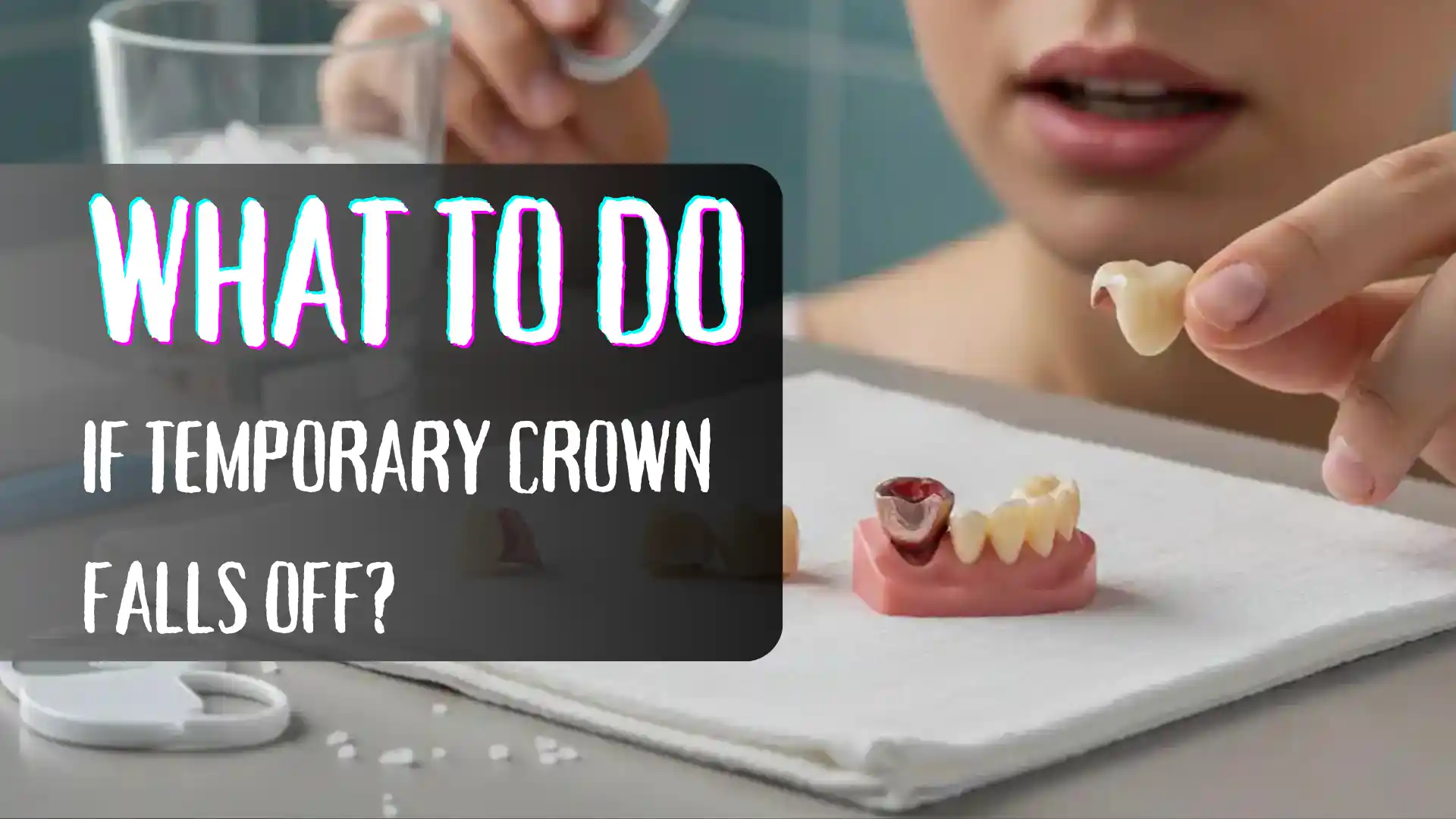Have you ever faced a situation in which you don’t know what to do if temporary crown falls off? Realizing that your temporary crown falls off can trigger immediate concern, but rest assured, this is a situation that dentists encounter regularly.
A temporary crown serves as a protective covering for your prepared tooth while a dental laboratory crafts your permanent crown, which typically takes one to two weeks. These interim crowns aren’t designed to last forever, so it’s not uncommon for them to become loose or detach completely. Whether it happened while eating, brushing, or seemingly out of nowhere, knowing exactly what to do if temporary crown falls off can save you unnecessary stress and protect your tooth until professional help is available. Apart from that, if you are struggling with what to do when a rotten tooth falls out, take a look at our other blog which will help you take the correct step.
What Do They has prepared an extensive blog so you know what to do if temporary crown falls off. We’ll walk through each step you should take, provide practical solutions for immediate relief, and explain when you should seek emergency dental care. With the right knowledge and quick action, you can handle this dental hiccup and answer to “what to do if temporary crown falls off?” with confidence.
Take a Deep Breath: A Common Issue
When your temporary crown falls off, your first reaction might be alarm or worry that you’ve done something wrong. However, it’s important to understand that temporary crowns are designed with less durable materials and weaker cement precisely because they’re meant to be replaced. Dentists expect that these temporary solutions might not stay perfectly in place until your permanent crown is ready.
Many patients experience a temporary crown falling off at least once, especially if they have the temporary crown for more than a few days. The prepared tooth underneath is typically still stable and protected, though it may feel sensitive or strange to your tongue. Remember that your dental team has procedures in place specifically for these situations, and they can guide you through the next steps without judgment.
Step 1: Find and Secure the Crown

If you are eating and get a crunchy sensation, analyze the object in your mouth. Is it a bit large than usual and has shallow side? If all the things are green signals, then you might panic thinking what to do if temporary crown falls off.
First, carefully check your food and surrounding area. If you’re near a sink, place a towel over the drain to prevent losing it down the pipes. Once you’ve found the temporary crown that falls off, handle it with care as it may have sharp edges. Rinse it gently under lukewarm water—never hot water, which could warp the material.
Use a soft toothbrush to carefully remove any food particles or old cement that might be stuck to it. After cleaning, place it in a secure container like a pill box or even wrap it in tissue and store it in a zippered pocket.
Bringing the temporary crown to your dental appointment increases the chances that your dentist can reattach it rather than having to create a new one.
Key points:
- Locate the crown immediately
- Clean it gently with lukewarm water
- Store it safely in a container
- Bring it to your dental appointment
Step 2: Check Your Tooth

Your second step to “what to do if temporary crown falls off”, take a moment to carefully assess the affected tooth and surrounding area. Using a mirror and good lighting, look at the exposed tooth—you’ll likely see it’s been reduced in size and shaped specifically to hold a crown. This prepared tooth might appear discolored, flat on top, or have a small mound in the center if a buildup was placed.
Gently run your tongue over it to check for any rough edges that might irritate your cheeks or tongue. Be aware that the tooth may feel extremely sensitive, particularly to air, temperature changes, or sweet foods, because the dentin layer is now exposed. In some cases, you might notice a small metal post (if you had a post and core buildup) or remnants of cement.
Key points:
- Examine the tooth carefully in good lighting
- Note any sensitivity or discomfort
- Look for any obvious irregularities
- Avoid probing the area with tools or fingernails
Step 3: Call Your Dentist

Contacting your dental office should be your priority when you don’t know what to do if temporary crown falls off. Many dental practices have emergency lines or protocols for situations exactly like this. When speaking with the dental staff, be specific about when your temporary crown falls off, what tooth is affected (for example, “upper right back tooth” or “lower front tooth”), and whether you’re experiencing pain.
If you’ve had recent work like a root canal on this tooth, be sure to mention that as well. Ask about the earliest available appointment, but also inquire if they have any cancellation lists you can be added to. Some dental offices might offer same-day emergency slots specifically for patients whose temporary crown falls off, so if you are confused on what to do if temporary crown falls off, you can contact your dental office first.
Key points:
- Contact your dentist as soon as possible
- Provide specific details about the tooth and situation
- Ask about emergency appointments
- Inquire about alternative providers if needed
Step 4: Temporary Solutions Before Your Appointment

The time between when your temporary crown falls off and your dental appointment requires some interim management to protect the exposed tooth. Beyond trying to reattach the crown yourself or using dental wax, there are several other protective measures you can take incase you are not familiar with what to do if temporary crown falls off.
For immediate sensitivity relief, you can apply a small amount of sensitive toothpaste directly to the tooth with your finger and let it sit. Over-the-counter dental repair kits containing temporary filling material can provide some protection if used carefully according to package directions. Clove oil applied with a cotton swab can help numb sensitivity, though use it sparingly as it has a strong taste.
Some patients find relief by fashioning a temporary cover from sugar-free gum (avoid sugar-containing gum as it can cause pain). Regardless of which temporary solution you choose, remember it’s just a stopgap until professional care—the exposed tooth is vulnerable to both sensitivity and potential damage, so treat it gently and maintain excellent oral hygiene around the area without directly brushing the exposed tooth surface.
Key points:
- Apply sensitive toothpaste for immediate relief
- Consider over-the-counter dental repair kits
- Use clove oil sparingly for numbing
- Maintain gentle oral hygiene around the area
Option 1: Try to Reattach It Yourself
The first logical option to what to do if temporary crown falls off is attempting to reattach your temporary crown when it falls off, as it can provide significant relief until you see your dentist. After placing the crown, bite down on a clean piece of gauze or a tea bag for a few minutes to ensure proper positioning. Once set, carefully remove any excess cement from around the edges using dental floss, being cautious not to dislodge the newly placed crown.
Option 2: Protect the Exposed Tooth
If reattachment isn’t possible when your temporary crown falls off, the second most important thing what to do if temporary crown falls off is protecting the vulnerable tooth becomes essential. After washing your hands thoroughly, take a small piece of sugar-free gum, chew it briefly until pliable but not sticky, then gently mold it over the exposed tooth to create a smooth surface. When eating, cut food into smaller pieces and place them away from the affected area, allowing you to chew on the opposite side more easily.
Managing Discomfort If Your Temporary Crown Falls Off

The discomfort experienced when your temporary crown falls off varies significantly from person to person and depends on factors such as tooth sensitivity, extent of the original dental work, and whether the tooth had root canal treatment.
Beyond basic pain management, several specific techniques can provide relief when searching for what to do if temporary crown falls off:
- Use salt water rinses for gentle cleaning and inflammation reduction
- Apply cold compresses to the external jaw area
- Elevate your head while resting
- Protect from air sensitivity with appropriate coverings
- Take medications as directed, never directly on tissues
Dietary Adjustments When Your Temporary Crown Falls Off
- Focus on room-temperature, nutritionally complete soft foods
- Incorporate protein-rich smoothies and soft-cooked grains
- Place food away from the affected area when eating
- Stay hydrated but avoid drinking through straws
- Track food sensitivities to discuss with your dentist
Why Temporary Crowns Fall Off
Understanding the engineering and design limitations of temporary crowns can help contextualize why they sometimes fail to stay in place. If you are thinking about what to do if temporary crown falls off, you should rather focus on why they fall off.
Temporary crowns are typically made from acrylic or composite materials that, while functional, lack the precise custom fit of permanent crowns crafted in a dental laboratory. The cement used for temporary crowns is intentionally formulated to be weaker than permanent cement—this allows for easy removal when your permanent crown arrives without damaging the underlying tooth structure. Additionally, the shape of the prepared tooth plays a role; sometimes teeth with minimal height (short clinical crowns) provide less surface area for the temporary crown to grip.
Environmental factors in your mouth also impact adhesion—variations in saliva composition can affect how well cement bonds, and natural mouth movements like speaking and swallowing create subtle forces that work against the crown over time. Temperature fluctuations from hot and cold foods cause microscopic expansion and contraction that can gradually loosen the temporary seal.
Key points:
- Temporary crowns use weaker materials by design
- Temporary cement is intentionally less adhesive
- Tooth shape affects retention capabilities
- Mouth environment and movements create ongoing challenges
- Temperature changes cause microscopic expansion and contraction
When to Worry If Your Temporary Crown Falls Off
While most instances of a temporary crown falling off aren’t true emergencies, certain developments warrant immediate professional attention. Beyond obvious concerns like severe pain or bleeding, watch for signs of infection developing around the tooth, which might include a persistent bad taste or odor that doesn’t resolve with rinsing, swelling of the gum tissue that progresses beyond the immediate area, or pimple-like bumps on the gum near the affected tooth.
If you notice pieces of the actual tooth (not just the crown) have broken off, this requires urgent care to prevent further deterioration. Additionally, if you experience radiating pain that extends beyond the tooth to your ear, jaw, or neck, or if you find it difficult to fully open or close your mouth, these could be signs of more complex issues requiring immediate professional assessment.
So the Answer to What to do if Temporary Crown Falls Off is…
When you don’t know what to do if temporary crown falls off, approaching the situation with calmness can make a significant difference in both your comfort and the ultimate outcome for your tooth. Remember that modern dentistry has evolved tremendously—what once might have been a serious dental emergency can now typically be managed effectively until proper care is available.
The temporary discomfort and inconvenience of dealing with a dislodged crown is far outweighed by the long-term benefits of properly completed dental work. Your temporary crown falling off does not mean your dental treatment has failed; rather, it’s simply a common hiccup in the process of restoring your smile to full health and function. With patience and proper care, you’ll soon have your permanent crown securely in place, designed specifically for your bite and made of durable materials that will serve you well for many years to come.








4 Comments